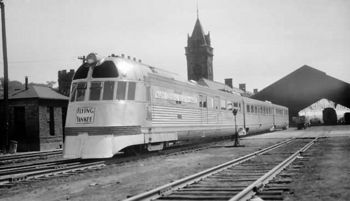Flying Yankee


The Flying Yankee was a diesel-powered streamliner built in 1935 for the Maine Central Railroad and Boston and Maine Corporation by Budd Company and with mechanical and electrical equipment from General Motors' Electro-Motive Division. It was the third streamliner train in North America after the Union Pacific Railroad's M-10000 and the Chicago, Burlington and Quincy Railroad's Pioneer Zephyr; the Flying Yankee was, in fact, a virtual clone of the latter, except that it dispensed with the baggage/mail space to seat 142 in three articulated cars.
The lightweight train was constructed with welded stainless steel using Budd's patented process. The engine was an 8-cylinder Winton 201-A diesel, driving a generator; the lead truck was equipped with traction motors. It was fitted with air conditioning in all cars. No dining car was provided; instead, meals were prepared in a galley and served to passengers in trays that clipped to the back of the seat in front.
The train was delivered in February 1935, and toured the BM-MEC railroad system before entering service on April 1. The daily route served began in Portland, Maine, then to Boston, Massachusetts, followed by a return to Portland and continuing to Bangor, Maine, returning through Portland to Boston and finally returning to Portland late in the day, a distance of 750 miles per day. This schedule was kept six days a week; the trainset spent Sundays undergoing maintenance. The train proved extremely successful, attracting new ridership and earning a profit for its owners.
Later on, as newer equipment replaced it on one route, it would be switched to other routes, bearing the names The Cheshire, The Minuteman, and The Business Man.
As railroad passenger ridership declined in the 1950s the Yankee was also getting old, and thus the trainset was retired, running its last on May 7, 1957. The railroad donated the trainset to the Edaville Railroad tourist / museum operation in Carver, Massachusetts. The train remained on static display there for about 40 years.
In 1997, the train was moved to the Claremont Concord Railroad's shops in Claremont, New Hampshire for a complete restoration, which is presently ongoing. As of 2004, the major structural restoration has been completed, and detailed restoration of components is proceeding. The eventual goal is to restore the train completely to running condition. The train was moved to Lincoln, New Hampshire, on August 10 2005, to the Hobo Railroad where the mechanical restoration will take place.
References
- Colquhoun, Lorna, New Hampshire Union Leader (August 11 2005), Flying Yankee rolls into Hobo Railroad. Retrieved August 11 2005.
- Lindblade, Carl E. and The Flying Yankee Restoration Group. The Story of the Flying Yankee. Retrieved from http://www.flyingyankee.com/history.html on December 19, 2004
- Pinkepank, Jerry A. (1973). The Second Diesel Spotter's Guide. Kalmbach Publishing Co., Milwaukee, WI. ISBN 0-89024-026-4.
External links
- The Flying Yankee Restoration Group - The organization that is undertaking the train's complete restoration.
Limited production and export locomotives built by EMD | |
|---|---|
| Electrics | SW1200MG · AEM-7 · GM6 · GM10 · GF6C |
| Industrial, military, export and narrow gauge | Model 40 · DDM45 · DHI · GMDH-1 · GMDH-3 · MRS-1 · GA8 · G8 · G12 · G16 · G26 · NF110 · NF210 · JT42CWR (Series 66) · JT42HW-HS · GT46MAC · GT22HW · GT46PAC |
| Streamliners | M-10000 · M-10001 · M-10002 · M-10003-6 · Pioneer Zephyr · General Pershing Zephyr · Green Diamond · Flying Yankee · Aerotrain |
| Experimentals | 1800 hp B-B |
| See also: List of EMD locomotives | |
